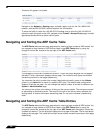
Network > ARP
370
SonicOS 5.8.1 Administrator Guide
Static ARP Entries
The Static ARP feature allows for static mappings to be created between layer 2 MAC
addresses and layer 3 IP addresses, but also provides the following capabilities:
• Publish Entry - Enabling the Publish Entry option in the Add Static ARP window causes
the SonicWALL device to respond to ARP queries for the specified IP address with the
specified MAC address. This can be used, for example, to have the SonicWALL device
reply for a secondary IP address on a particular interface by adding the MAC address of
the SonicWALL. See the Secondary Subnet section that follows.
• Bind MAC Address - Enabling the Bind MAC Address option in the Add Static ARP
window binds the MAC address specified to the designated IP address and interface. This
can be used to ensure that a particular workstation (as recognized by the network card's
unique MAC address) can only the used on a specified interface on the SonicWALL. Once
the MAC address is bound to an interface, the SonicWALL will not respond to that MAC
address on any other interface. It will also remove any dynamically cached references to
that MAC address that might have been present, and it will prohibit additional (non-unique)
static mappings of that MAC address.
• Update IP Address Dynamically - The Update IP Address Dynamically setting in the
Add Static ARP window is a sub-feature of the Bind MAC Address option. This allows for
a MAC address to be bound to an interface when DHCP is being used to dynamically
allocate IP addressing. Enabling this option will blur the IP Address field, and will populate
the ARP Cache with the IP address allocated by the SonicWALL's internal DHCP server,
or by the external DHCP server if IP Helper is in use.
Secondary Subnets with Static ARP
The Static ARP feature allows for secondary subnets to be added on other interfaces, and
without the addition of automatic NAT rules.


















